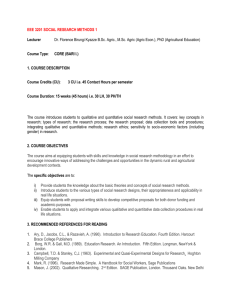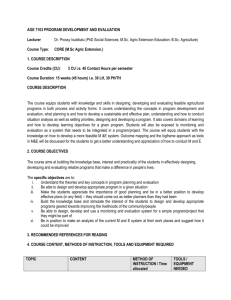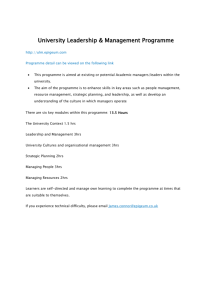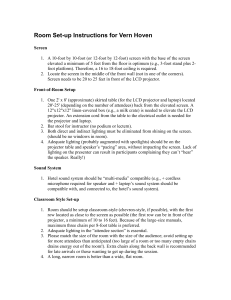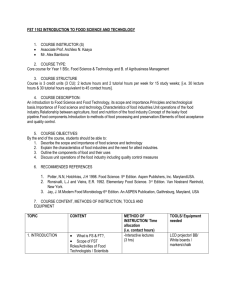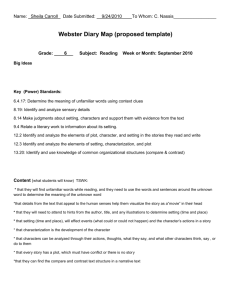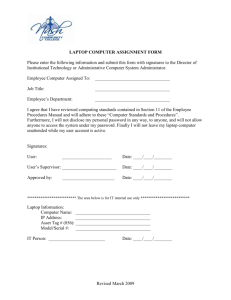ARI 1102 Introduction to Communication for Agrarian Development
advertisement
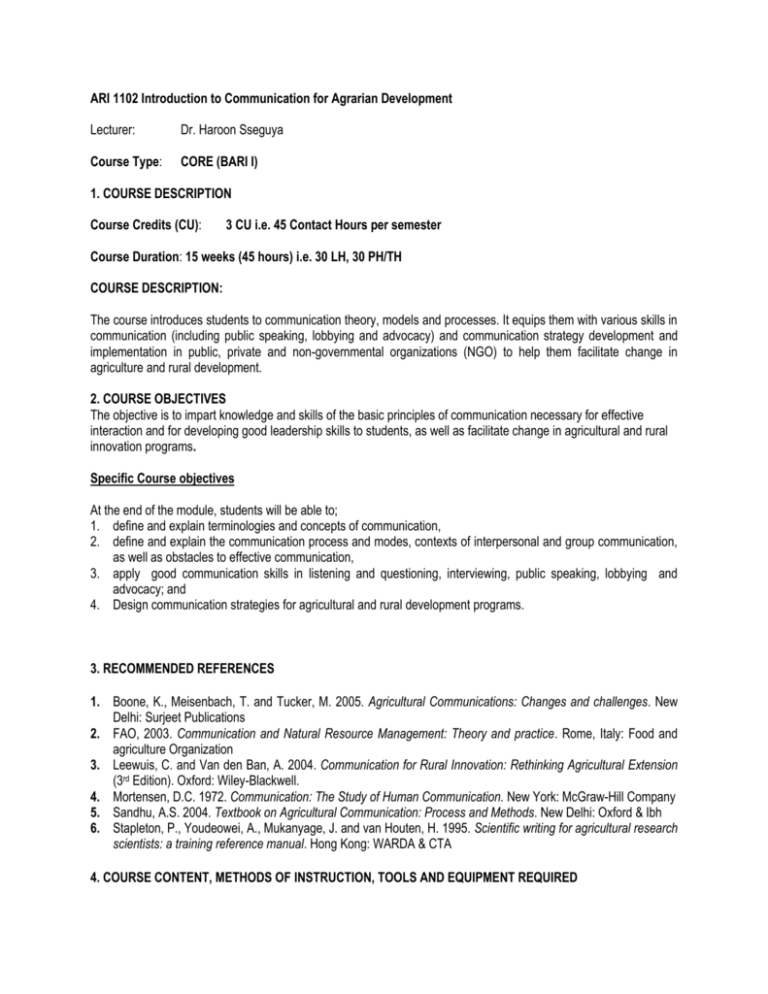
ARI 1102 Introduction to Communication for Agrarian Development Lecturer: Dr. Haroon Sseguya Course Type: CORE (BARI I) 1. COURSE DESCRIPTION Course Credits (CU): 3 CU i.e. 45 Contact Hours per semester Course Duration: 15 weeks (45 hours) i.e. 30 LH, 30 PH/TH COURSE DESCRIPTION: The course introduces students to communication theory, models and processes. It equips them with various skills in communication (including public speaking, lobbying and advocacy) and communication strategy development and implementation in public, private and non-governmental organizations (NGO) to help them facilitate change in agriculture and rural development. 2. COURSE OBJECTIVES The objective is to impart knowledge and skills of the basic principles of communication necessary for effective interaction and for developing good leadership skills to students, as well as facilitate change in agricultural and rural innovation programs. Specific Course objectives At the end of the module, students will be able to; 1. define and explain terminologies and concepts of communication, 2. define and explain the communication process and modes, contexts of interpersonal and group communication, as well as obstacles to effective communication, 3. apply good communication skills in listening and questioning, interviewing, public speaking, lobbying and advocacy; and 4. Design communication strategies for agricultural and rural development programs. 3. RECOMMENDED REFERENCES 1. Boone, K., Meisenbach, T. and Tucker, M. 2005. Agricultural Communications: Changes and challenges. New Delhi: Surjeet Publications 2. FAO, 2003. Communication and Natural Resource Management: Theory and practice. Rome, Italy: Food and agriculture Organization 3. Leewuis, C. and Van den Ban, A. 2004. Communication for Rural Innovation: Rethinking Agricultural Extension (3rd Edition). Oxford: Wiley-Blackwell. 4. Mortensen, D.C. 1972. Communication: The Study of Human Communication. New York: McGraw-Hill Company 5. Sandhu, A.S. 2004. Textbook on Agricultural Communication: Process and Methods. New Delhi: Oxford & Ibh 6. Stapleton, P., Youdeowei, A., Mukanyage, J. and van Houten, H. 1995. Scientific writing for agricultural research scientists: a training reference manual. Hong Kong: WARDA & CTA 4. COURSE CONTENT, METHODS OF INSTRUCTION, TOOLS AND EQUIPMENT REQUIRED TOPIC 1. Communication: an introduction CONTENT 2. Communication theories and models Discussion of class overview METHOD OF INSTRUCTION / Time allocated Interactive Lectures (4hrs) TOOLS / EQUIPMENT NEEDED Flash cards, Markers White Board, Laptop, LCD Projectors, Paper Interactive Lectures (3hrs) Flash cards, Markers White Board, Laptop, LCD Projectors, Paper Communication and its role in research and development; Purpose and nature of communication Communication theories and models: conceptualization Tutorial sessions (2hrs) Reading Assignment Different communication models and Interactive Lectures their implications for agricultural and (4hrs) rural development Tutorial sessions (2hrs) 3. Communication barriers and misconceptions 4. Communication skills Communication barriers Communication misconceptions How to overcome the barriers and misconceptions Introduction to communication skills Listening and questioning skills Public speaking skills Reading Assignment Interactive Lecture (3hrs) Markers White Board, Laptop, LCD Projector, Tutorial sessions (2hrs) Interactive Lectures (3hrs) Markers White Board, Laptop, LCD Projector, Tutorial sessions (2 hrs) Reading Assignment Lobbying and advocacy (rationale Interactive Lectures for lobbying and advocacy, steps in (3hrs) developing lobbying and advocacy plans, practicum on developing Tutorial sessions (3hrs) lobbying and advocacy materials) Communication skills practicum Markers White Board, Laptop, LCD Projectors Paper Reading Assignment Practical sessions 6 hours Markers White Board, Laptop, LCD Projector Markers White Board, Laptop, LCD Projector, 5. Communication strategies: design and implementation 6. Integrating quantitative and qualitative data Importance of Communication Strategies Interactive Lectures (3hrs) in agricultural & rural development Desktop computers Markers White Board, Laptop, LCD Projector, Reading assignment Strategies and steps in developing a Interactive Lectures (4hrs) communication Strategy Markers White Board, Laptop, LCD Projector, Tutorials (3hrs) Implementing, monitoring and evaluating a communication strategy Reading Assignment Interactive Lectures (3hrs) Practicum on design of a communication strategy Tutorial (2 hours) Tutorial Sessions (2hrs) Practical sessions (6 hours) 5. SUMMARY OF TIME NEEDED Interactive lectures covering theory Tutorial Hours Practical sessions 30 hrs 18 hrs 12 hrs 6. OVERALL COURSE EVALUATION Continuous Assessment Test Individual and group assignments Final examination 20% 20% 60%. Markers White Board, Laptop, LCD Projector Markers White Board, Laptop, LCD Projector, Desktop computers
